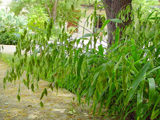Native Plants

Q. Who is Mr. Smarty Plants?
A: There are those who suspect Wildflower Center volunteers are the culpable and capable culprits. Yet, others think staff members play some, albeit small, role. You can torture us with your plant questions, but we will never reveal the Green Guru's secret identity.
Did you know you can access the Native Plant Information Network with your web-enabled smartphone?
Ask Mr. Smarty Plants is a free service provided by the staff and volunteers at the Lady Bird Johnson Wildflower Center.

rate this answer
Wednesday - November 03, 2010
From: Shiro, TX
Region: Southwest
Topic: Propagation
Title: Planting wildflower seeds in a drought in Grimes Co. TX
Answered by: Barbara Medford
QUESTION:
I have a dilemma, shared by others I'm sure. My place, which is in Oakland prairie, has seen no real rainfall since sometime in August, and the soil (sand, loam, and blackland clays)is extremely dry. I have seeds for lanceleaf coreopsis,Indian blanket, inland sea oats, and Drummond phlox which I normally would plant anticipating fall rains, but it doesn't look like we are going to get much according to NOAA. Any suggestions? Shall I wait longer or for spring? Additional watering is pretty much out of the question.ANSWER:
Be of good cheer, Coreopsis lanceolata (Lanceleaf coreopsis), Gaillardia pulchella (Firewheel), Chasmanthium latifolium (Inland sea oats), and Phlox drummondii (Annual phlox all are native to the Grimes County area. As a result, they are accustomed by millennia of experience to living even when conditions get a little challenging. You can follow each plant link above to get the specific propagation instructions from our page on that particular plant.
The Indian blanket and phlox are both annuals. It is important to get them in the soil in the Fall to ensure some seed-bearing plants next year to perpetuate themselves. The Coreopsis and Inland Sea Oats are both perennials, to be planted in either Fall or Spring. Since perennials seldom bloom until the second growing season, planting the coreopsis in the Fall should ensure that you will get at least some blooms next year. The Inland Sea Oats is really better planted in the early Spring, as that is when the seeds germinate anyway.
With or without rain, we would suggest that you go ahead and get at least some of the seeds in the ground. Make sure they make good contact with the soil, perhaps raking them lightly, to wait for rain. As is usual with native seeds, some of those seeds may wait in the soil for years before they get the right conditions and come up. Then, in the Spring, plant some more; with reseeding and perpetuation you should have years of blooms.
From our Native Plant Image Gallery:
More Propagation Questions
Choosing the right Coreopsis species for Tennessee
November 28, 2015 - I live in Bristol Tennessee and have replaced most of my lawn with native plants. I have been trying to learn more about the Coreopsis genus. In TN, we have C. auriculata, grandiflora, lanceolata, m...
view the full question and answer
Propagation of Emory Oak acorns
May 08, 2005 - Dear Wildflower Experts,
By any chance do you know how we could obtain some Emory Oak acorns to plant on our farm on the Eastern Shore of Maryland? I know itís not a given that the trees would grow...
view the full question and answer
Proper method of scattering bluebonnet seeds
December 18, 2008 - I scattered about 20 lbs of bluebonnet seeds during various times this past fall season. I have read that it is a must to plant the seeds about an 1/8" of an inch into the ground rather than surface ...
view the full question and answer
Plants for Daisy Girl Scout native plants project
December 13, 2013 - Hello,
I am a daisy Girl Scout leader and we are working on one of our Journeys and Native Plants Patch Program which requires our group of 5-6 year old girls to plant and care for a mini-garden. ...
view the full question and answer
Propagation of Eastern Redbud
March 25, 2005 - I have collected seeds from an Eastern Redbud (Cercis canadensis L.) and I want to learn how to germinate them. How can I find out this information?
view the full question and answer
| Support the Wildflower Center by Donating Online or Becoming a Member today. |

